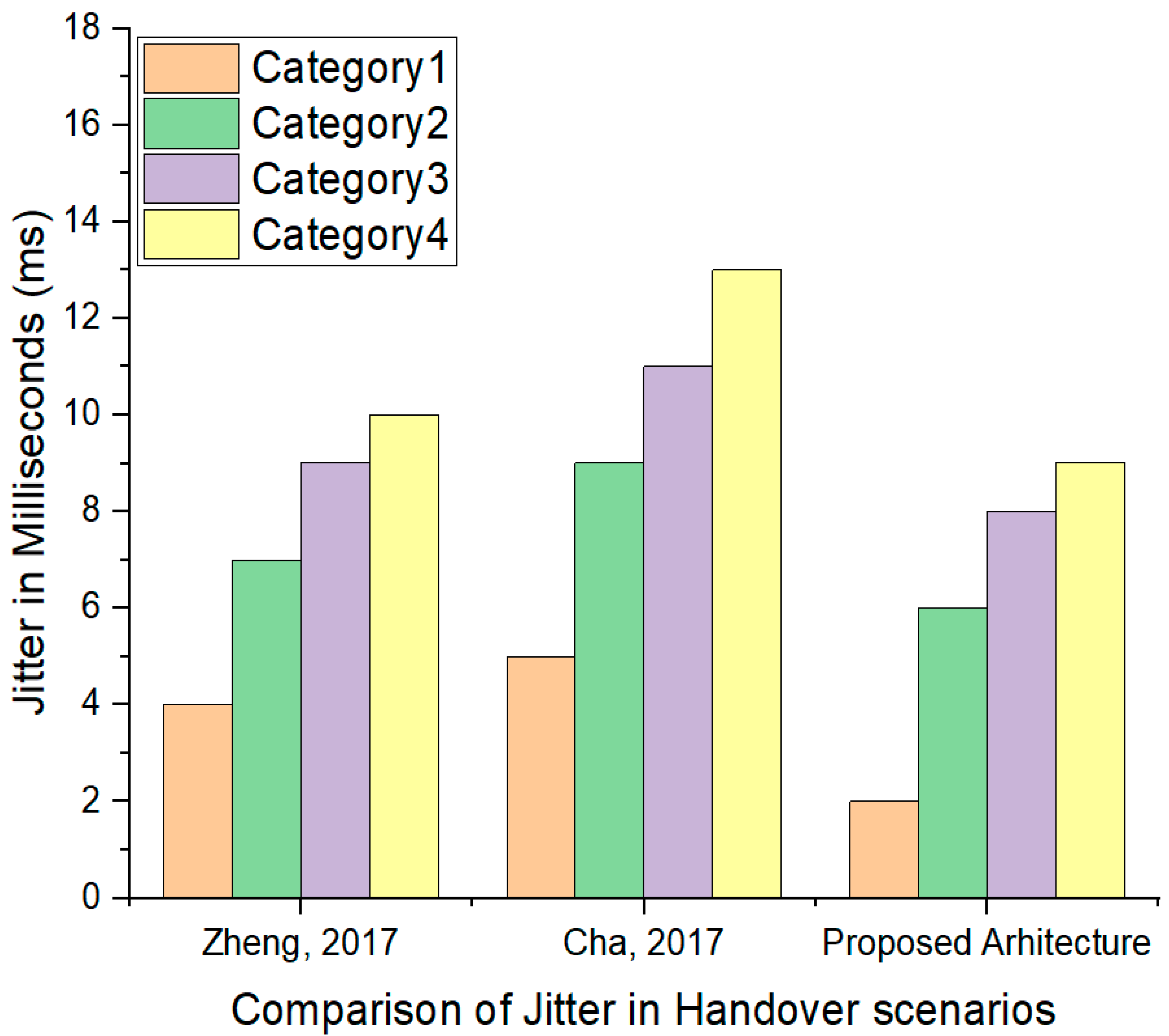Leveraging Software-Defined Networking for a QoS-Aware Mobility Architecture for Named Data Networking
Abstract
1. Introduction
Problem Formulation and Our Proposed Solution
- The design of SDPCACM (software-defined proactive caching architecture for consumer mobility) in NDN that extends the SDN model to allow mobility control for the NDN architecture (NDNA), through which the MC (mobile consumer) receives the data proactively after handover while the MC is moving. When an MC is watching a real-time video in a state of mobility and changing their position from one access point to another, the controllers in SDN preserve the network layout and topology as well as link metrics to transfer updated routes with the occurrence of the handoff or handover scenario, and through the proactive caching mechanism, the previous access router proactively sends the desired packets to the new connected routers.
- We also illustrate the SDPCACM with respect to NDN regarding the intra- along with inter-domain handover management scenarios to sustain routing stability with the existence and presence of consumer mobility. Additionally, we present the SDPCACM’s ability to efficiently control consumer mobility as well as request stuffiness issues, to decrease the loss of interest, and the hand-off delay for data packet.
- This paper offers an illustrative methodology and parameter configuration for virtual machines (VMs), OpenFlow switches, and real open daylight (ODL) SDN controllers.
- Finally, we conduct the simulation of the proposed SDPCACM for NDN using an emulated environment that is transmittable on the hardware directly. The experimental result shows that our scheme is significant in terms of delay time, CPU usage, packet loss ratio, jitter, and throughput, etc. Moreover, we make comparisons using experiments for NDN, SDN, and our proposed approach of leveraging SDN in NDN for mobility.
2. Background and Literature Review
2.1. Named Data Networking (NDN) Overview
2.2. SDN Model for NDN
2.2.1. A. Infrastructure Layer
2.2.2. B. Control Layer
2.2.3. C. Application Layer
2.3. Review of NDN Mobility
3. Proposed Scheme
3.1. Proposed SDPCACM Design for NDN
3.1.1. Network Model
A. User
B. NDN Router
C. Communication Procedure
D. SDN Controller
- Centralized control: SDN controllers provide a centralized point of control for network devices, enabling network administrators to manage and control network traffic in real-time. This is particularly important in a mobile network where devices are constantly moving and changing their location.
- Dynamic routing: In SDN, the network topology can be changed dynamically, allowing network administrators to route traffic to the most efficient path. This is essential in a mobile network where devices are moving in and out of coverage areas and need to be rerouted to ensure seamless connectivity.
- Traffic engineering: SDN controllers allow for fine-grained traffic engineering, enabling network administrators to direct traffic to specific devices or areas of the network. This is important in a mobile network where devices are moving in and out of coverage areas and need to be directed to the most optimal path.
- Network segmentation: SDN controllers allow for network segmentation, which enables network administrators to isolate network traffic from different devices and users. This is important in a mobile network where devices are constantly moving and may be carrying sensitive data.
- QoS control: SDN controllers allow for the implementation of quality of service (QoS) policies, which enable network administrators to prioritize traffic based on its importance. This is important in a mobile network where devices are constantly competing for bandwidth and need to be prioritized based on their importance.
3.2. Overview of Proposed SDPCACM Corresponding to NDN
3.2.1. Initialization Phase
3.2.2. A Single SDN Controller Scenario
3.2.3. Intra-Domain Handover Operating Scenario
3.2.4. A Multi- (More Than One Controller) SDN Scenario
3.2.5. Inter-Domain Handover Use and Control Scenario
4. Simulation and Evaluation
4.1. Experimental Setup
4.1.1. Parameters under the Evaluation to Validate the Effectiveness of Our Proposed Strategy
A. Delay Measurement
B. Throughput Measurement
C. CPU Utilization
D. Packet Loss Ratio
| Algorithm 1: Traffic production Algorithm |
| Step 1: Execute the graphical interface on H2. Step 2: At H2, modify the current directory and change to D-ITG/bin Step 3: Then give command: /ITGRecv at the H2 terminal. Step 4: In addition, open the GUI terminal of H1 host. Step 5: Then execute command on sending host H1: /ITGSend -T TCP -A 192.168.1.50 -c 500 -C 10,00 -t 2000 -l sender.log -x receiver.log Step 6: Then, perform log analysis for on H1, as well as H2 Step 7: At H1: /ITGDec sender.log execute it Step 8: At H2: /ITGDec receiver.log execute this command |
E. Jitter Evaluation
5. Conclusions
Author Contributions
Funding
Data Availability Statement
Acknowledgments
Conflicts of Interest
References
- Jiménez-Lázaro, M.; Herrera, J.L.; Berrocal, J.; Galán-Jiménez, J. Improving the Energy Efficiency of Software-Defined Networks through the Prediction of Network Configurations. Electronics 2022, 11, 2739. [Google Scholar] [CrossRef]
- Ali, J.; Roh, B.-H. An Effective Approach for Controller Placement in Software-Defined Internet-of-Things (SD-IoT). Sensors 2022, 22, 2992. [Google Scholar] [CrossRef] [PubMed]
- Siris, V.A.; Ververidis, C.N.; Polyzos, G.C.; Liolis, K.P. Information-Centric Networking (ICN) Architectures for Integration of Satellites into the Future Internet. In Proceedings of the 2012 IEEE First AESS European Conference on Satellite Telecommunications (ESTEL), Rome, Italy, 2–5 October 2012; pp. 1–6. [Google Scholar]
- Vasilakos, A.V.; Li, Z.; Simon, G.; You, W. Information centric network: Research challenges and opportunities. J. Netw. Comput. Appl. 2015, 52, 1–10. [Google Scholar] [CrossRef]
- Ahlgren, B.; Dannewitz, C.; Imbrenda, C.; Kutscher, D.; Ohlman, B. A survey of information-centric networking. IEEE Commun. Mag. 2012, 50, 26–36. [Google Scholar] [CrossRef]
- Gritter, M.; Cheriton, D.R. An Architecture for Content Routing Support in the Internet. In Proceedings of the 3rd USENIX Symposium on Internet Technologies and Systems (USITS 01), San Francisco, CA, USA, 26–28 March 2001. [Google Scholar]
- Stanford University TRIAD Project, (Online). Available online: www.dsg.stanford.edu/triad/ (accessed on 20 January 2023).
- Carzaniga, A.; Wolf, A.L. Content-Based Networking: A New Communication Infrastructure. In Workshop on Infrastruture for Mobile and Wireless Systems; Springer: Berlin/Heidelberg, Germany, 2001; pp. 59–68. [Google Scholar]
- Torres, J.; Ferraz, L.; Duarte, O.C.M.B. Controller-Based Routing Scheme for Named Data Network. Electr. Eng. Program COPPE/UFRJ Tech. Rep. 2012. Available online: https://www.gta.ufrj.br/ftp/gta/TechReports/TFD12.pdf (accessed on 20 January 2023).
- Azamuddin, W.M.H.; Aman, A.H.M.; Hassan, R.; Mansor, N. Comparison of Named Data Networking Mobility Methodology in a Merged Cloud Internet of Things and Artificial Intelligence Environment. Sensors 2022, 22, 6668. [Google Scholar] [CrossRef]
- Saxena, D.; Raychoudhury, V.; Suri, N.; Becker, C.; Cao, J. Named Data Networking: A survey. Comput. Sci. Rev. 2016, 19, 15–55. [Google Scholar] [CrossRef]
- Sinky, H.; Khalfi, B.; Hamdaoui, B.; Rayes, A. Responsive Content-Centric Delivery in Large Urban Communication Networks: A Link NYC Use-Case. IEEE Trans. Wirel. Commun. 2018, 17, 1688–1699. [Google Scholar] [CrossRef]
- Zhu, Z.; Afanasyev, A.; Zhang, L. A New Perspective on Mobility Support. NDN Tech. Rep. 2013, 13, 1–6. Available online: http://new.named-data.net/wp-content/uploads/TRmobility.pdf (accessed on 12 January 2022).
- Detti, A.; Bracciale, L.; Loreti, P.; Rossi, G.; Blefari Melazzi, N. A cluster-based scalable router for information centric networks. Comput. Netw. 2018, 142, 24–32. [Google Scholar] [CrossRef]
- Farahat, H. Proactive Caching to Support Mobility in Named Data Networks. Ph.D. Thesis, Queen’s University, Kingston, ON, Canada, June 2017. [Google Scholar]
- Torres, J.V.; Alvarenga, I.D.; Boutaba, R.; Duarte, O.C.M.B. Evaluating CRoS-NDN: A comparative performance analysis of a controller-based routing scheme for named-data networking. J. Internet Serv. Appl. 2019, 10, 20. [Google Scholar] [CrossRef]
- Cha, J.H.; Choi, J.H.; Kim, J.Y.; Han, Y.H.; Min, S.G. A mobility link service for ndn consumer mobility. Wireless Commun. Mobile Comput. 2018, 2018, 5149724. [Google Scholar] [CrossRef]
- Fang, C.; Yu, F.R.; Huang, T.; Liu, J.; Liu, Y. A survey of green information-centric networking: Research issues and challenges. IEEE Commun. Surv. Tutor. 2015, 17, 1455–1472. [Google Scholar] [CrossRef]
- Yi, C.; Afanasyev, A.; Wang, L.; Zhang, B.; Zhang, L. Adaptive forwarding in named data networking. ACM SIGCOMM Comput. Commun. Rev. 2012, 42, 62–67. [Google Scholar] [CrossRef]
- Kreutz, D.; Ramos, F.M.; Verissimo, P.E.; Rothenberg, C.E.; Azodolmolky, S.; Uhlig, S. Software-defined networking: A comprehensive survey. Proc. IEEE 2014, 103, 14–76. [Google Scholar] [CrossRef]
- Todorova, M.S.; Todorova, S.T. DDoS attack detection in SDN-based VANET architectures. Master’s Thesis, Aalborg University, Aalborg, Denmark, 2016; 175p. [Google Scholar]
- Liu, Z.; Wu, Y.; Yuepeng, E.; Ge, J.; Li, T. Experimental Evaluation of Consumer Mobility on Named Data Networking. In Proceedings of the 2014 Sixth International Conference on Ubiquitous and Future Networks (ICUFN), Shanghai, China, 8–11 July 2014; pp. 176–472. [Google Scholar]
- Ooka, A.; Ata, S.; Koide, T.; Shimonishi, H.; Murata, M. OpenFlow-Based Content-Centric Networking Architecture and Router Implementation. In Proceedings of the 2013 Future Network & Mobile Summit, Lisboa, Portugal, 3–5 July 2013; pp. 1–10. [Google Scholar]
- Ali, I.; Lim, H. Anchor-Less Producer Mobility Management in Named Data Networking for Real-Time Multimedia. Mob. Inf. Syst. 2019, 2019, 3531567. [Google Scholar] [CrossRef]
- Zheng, Y.; Piao, X.; Lei, K. Anchor-Chain: A Seamless Producer Mobility Support Scheme in NDN. In Proceedings of the 2017 IEEE 85th Vehicular Technology Conference (VTC Spring), Sydney, NSW, Australia, 4–7 June 2017; pp. 1–6. [Google Scholar] [CrossRef]
- Cha, J.-H.; Choi, J.-H.; Kim, J.-Y.; Min, S.-G.; Han, Y.H. A mobility link service in NDN face to support consumer mobility service. In Proceedings of the 2017 Ninth International Conference on Ubiquitous and Future Networks (ICUFN), Milan, Italy, 4–7 July 2017; pp. 444–449. [Google Scholar] [CrossRef]
- Ali, J.; Adnan, M.; Gadekallu, T.R.; Jhaveri, R.H.; Roh, B.H. A QoS-Aware Software Defined Mobility Architecture for Named Data Networking. In Proceedings of the 2022 IEEE Globecom Workshops (GC Wkshps), Rio de Janeiro, Brazil, 4–8 December 2022; pp. 444–449. [Google Scholar] [CrossRef]
- Sun, Q.; Wendong, W.; Hu, Y.; Que, X.; Xiangyang, G. SDN-Based Autonomic CCN Traffic Management. In Proceedings of the 2014 IEEE Globecom Workshops (GC Wkshps), Austin, TX, USA, 8–12 December 2014; pp. 183–187. [Google Scholar]
- Rao, Y.; Zhou, H.; Gao, D.; Luo, H.; Liu, Y. Proactive Caching for Enhancing User-Side Mobility Support in Named Data Networking. In Proceedings of the Seventh International Conference on Innovative Mobile and Internet Services in Ubiquitous Computing, Taichung, Taiwan, 3–5 July 2013; pp. 37–42. [Google Scholar]
- Torres, J.; Duarte, O.C.M. CRoS-NDN: Controller-Based Routing Strategy for Named Data Networking; Universidade Federal do Rio de Janeiro GTA/COPPE/UFRJ: Rio de Janeiro, Brazil, 2014; pp. 1–6. [Google Scholar]
- Aubry, E.; Silverston, T.; Chrisment, I. SRSC: SDN-Based Routing Scheme for CCN. In Proceedings of the 2015 1st IEEE Conference on Network Softwarization (NetSoft), London, UK, 13–17 April 2015; pp. 1–5. [Google Scholar]
- Eum, S.; Jibiki, M.; Murata, M.; Asaeda, H.; Nishinaga, N. An ICN Architecture within the Framework of SDN. In Proceedings of the 2015 Seventh International Conference on Ubiquitous and Future Networks, Sapporo, Japan, 7–10 July 2015. [Google Scholar]
- Rowshanrad, S.; Parsaei, M.R.; Keshtgari, M. Implementing NDN using SDN: A review on methods and applications. IIUM Eng. J. 2016, 17, 11–20. [Google Scholar] [CrossRef]
- Rehman, M.A.U.; Ullah, R.; Kim, B.S. NINQ: Name-Integrated Query Framework for Named-Data Networking of Things. Sensors 2019, 19, 2906. [Google Scholar] [CrossRef]
- Ali, J.; Roh, B.H. Quality of service improvement with optimal software-defined networking controller and control plane clustering. Comput. Mater. Contin. 2021, 67, 849–875. [Google Scholar] [CrossRef]
- Wang, G.; Zhao, Y.; Huang, J.; Wu, Y. An Effective Approach to Controller Placement in Software Defined Wide Area Networks. IEEE Trans. Netw. Serv. Manag. 2018, 15, 344–355. [Google Scholar] [CrossRef]
- Iperf. Available online: https://iperf.fr/ (accessed on 19 March 2023).
- Multi-Threaded Benchmark Tool. Available online: https://github.com/akopytov/sysbench (accessed on 20 January 2023).
- Botta, A.; Dainotti, A.; Pescape, A. A tool for the generation of realistic network workload for emerging networking scenarios. Comput. Netw. 2012, 56, 3531–3547. [Google Scholar] [CrossRef]

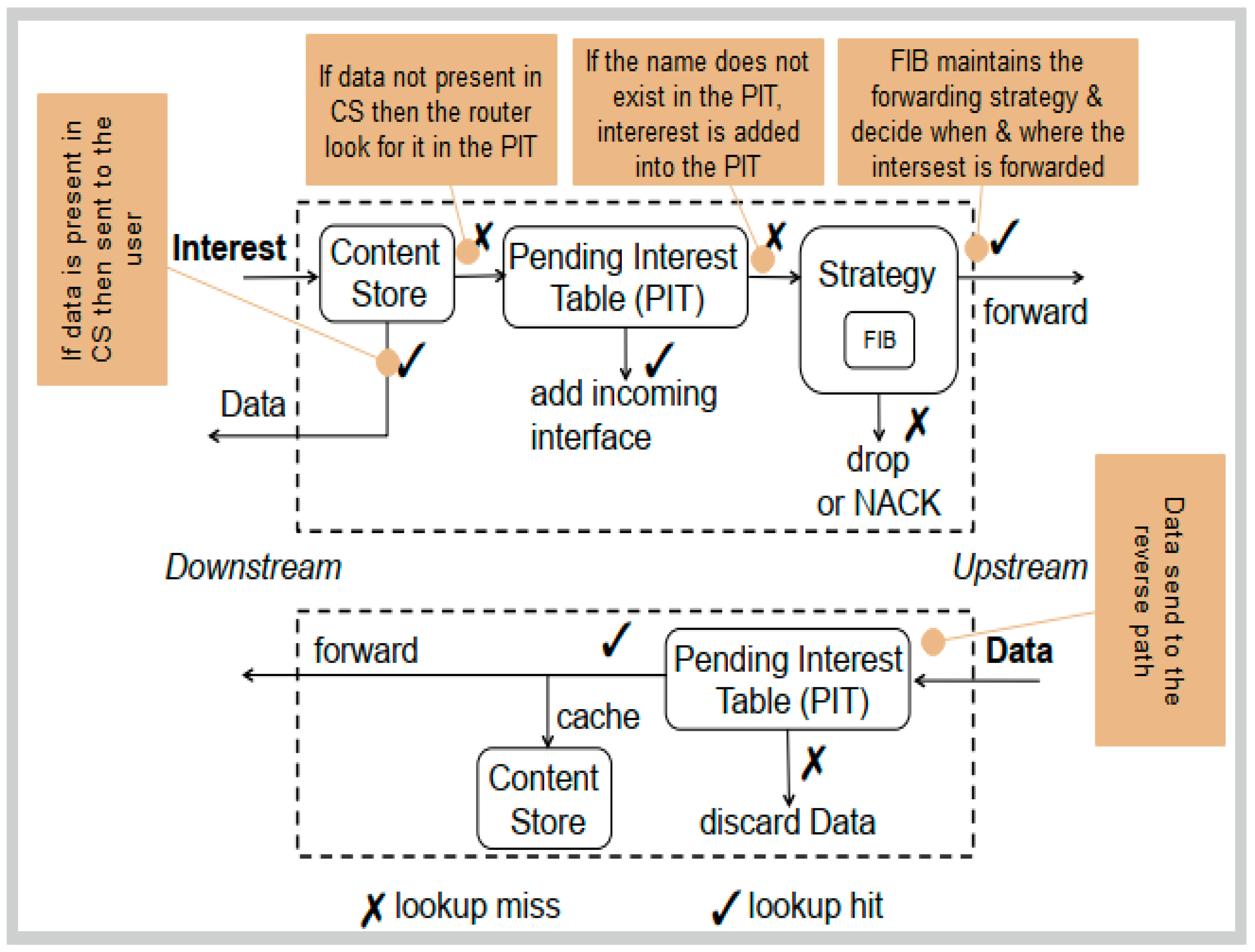

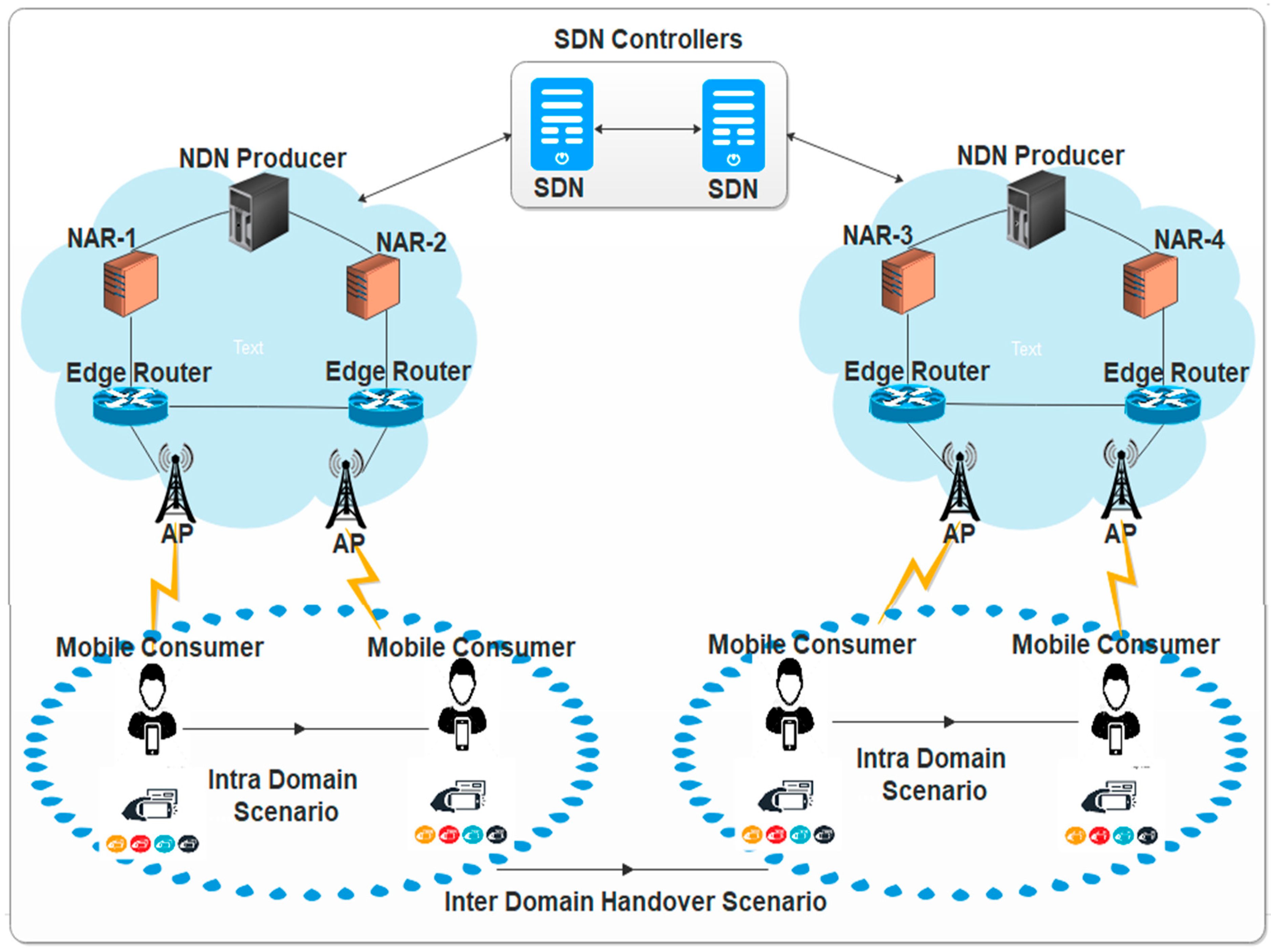
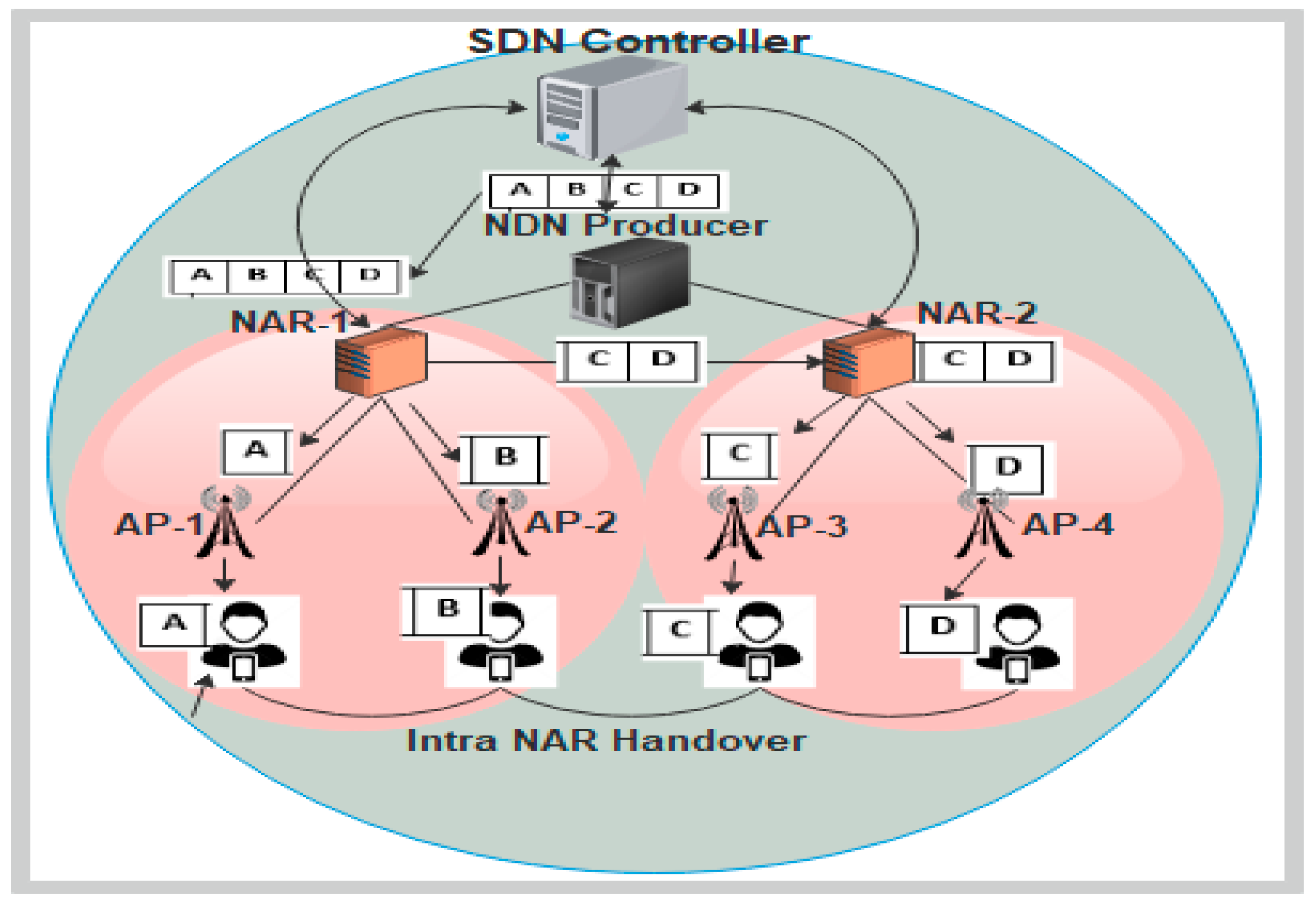
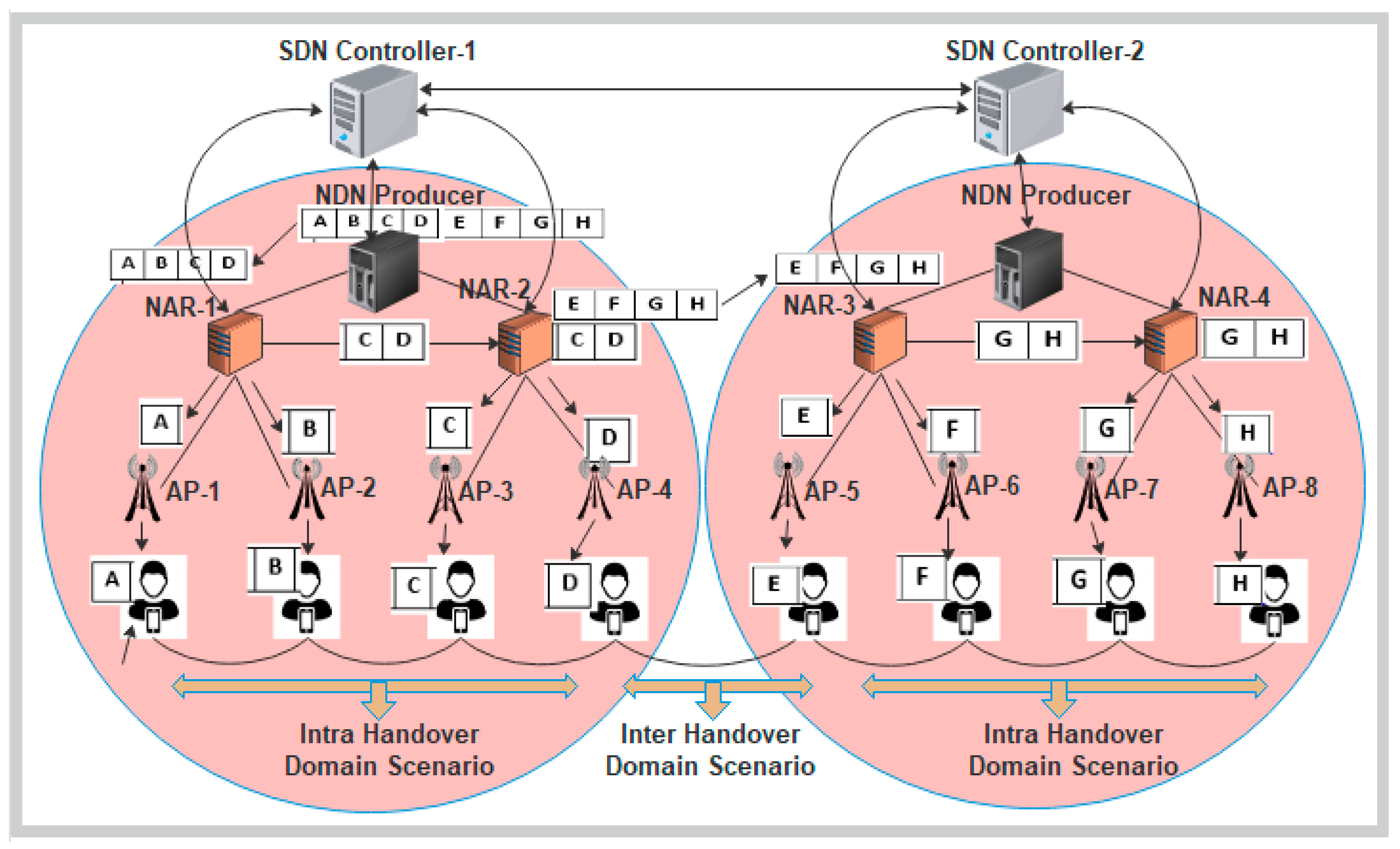

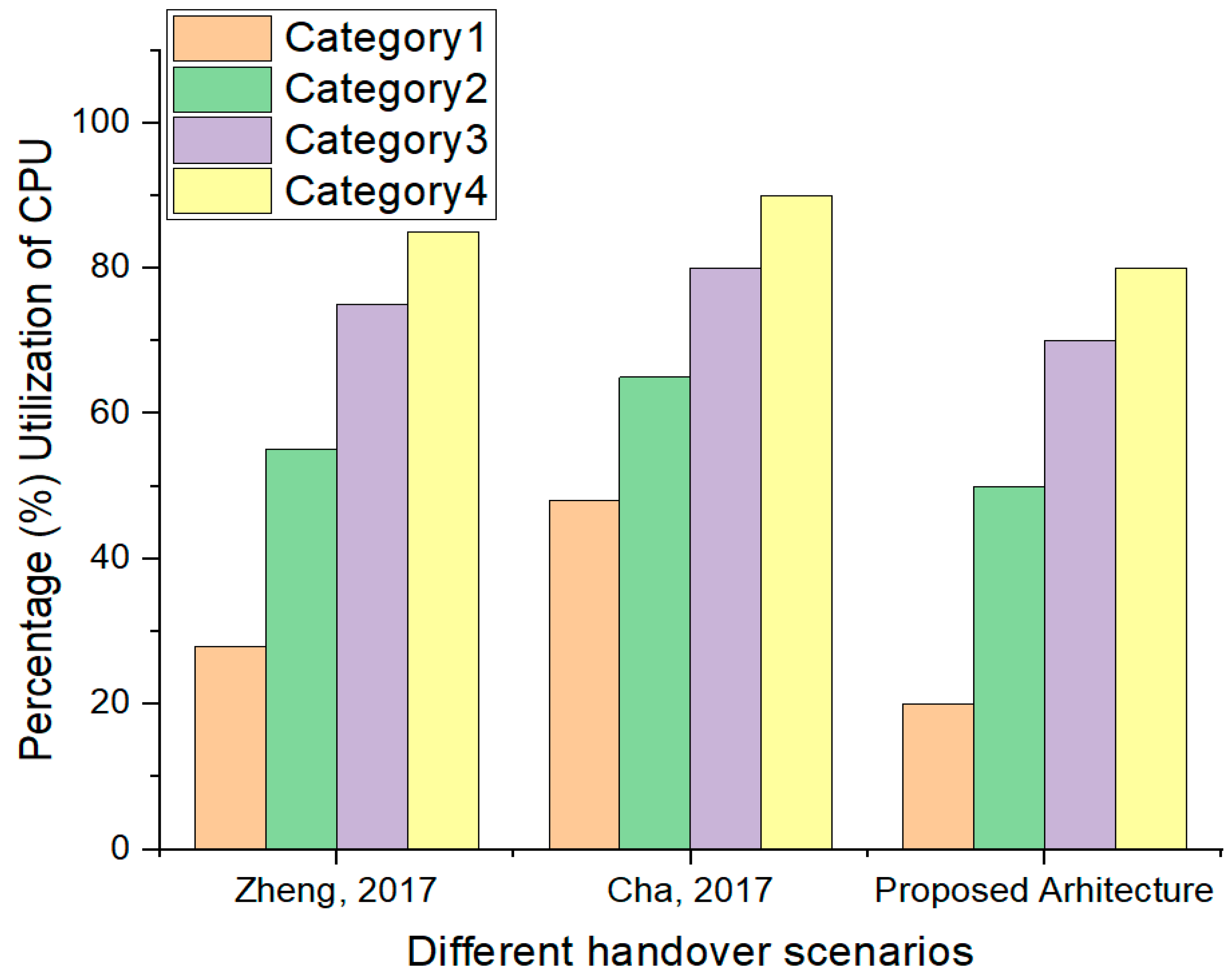
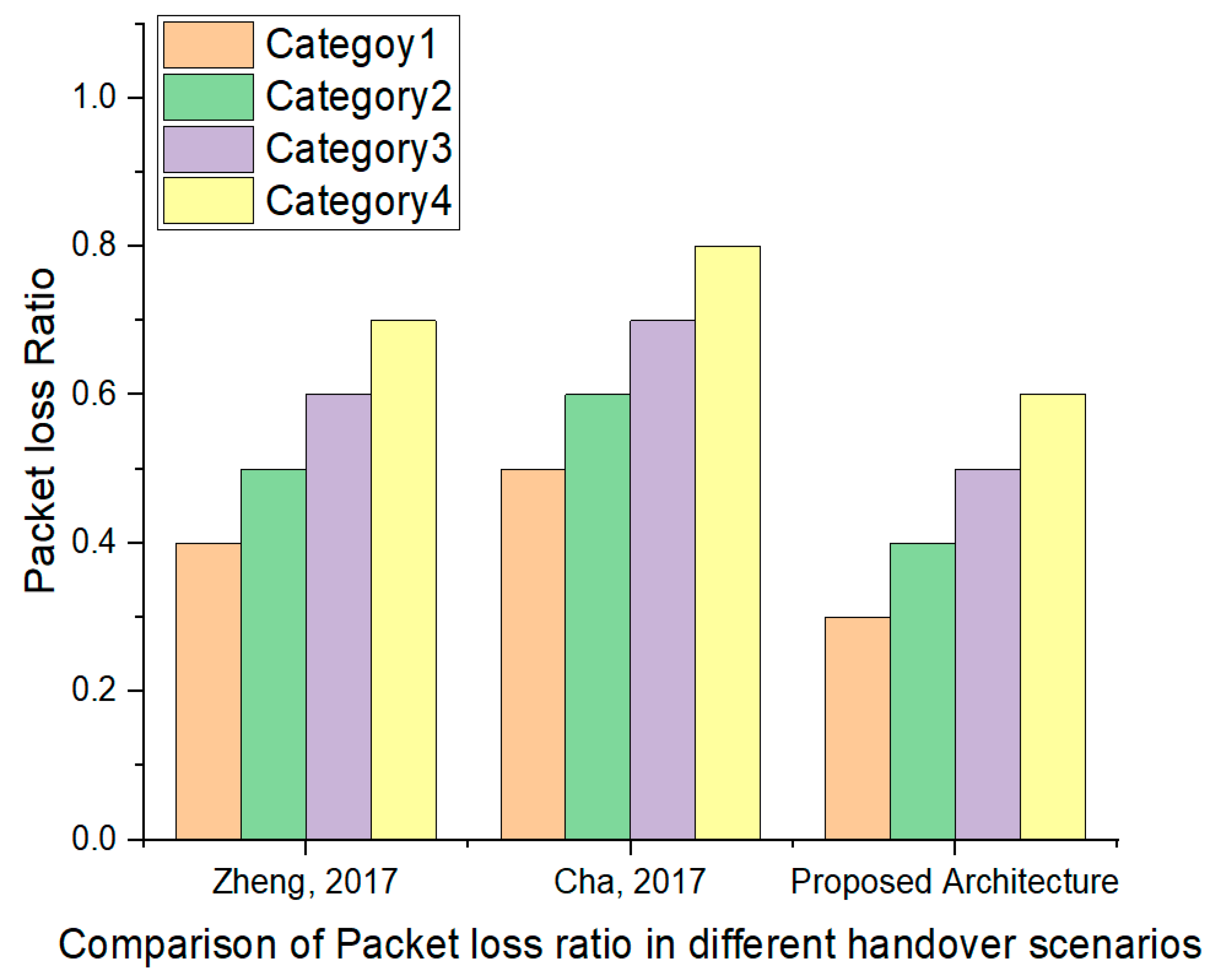
Disclaimer/Publisher’s Note: The statements, opinions and data contained in all publications are solely those of the individual author(s) and contributor(s) and not of MDPI and/or the editor(s). MDPI and/or the editor(s) disclaim responsibility for any injury to people or property resulting from any ideas, methods, instructions or products referred to in the content. |
© 2023 by the authors. Licensee MDPI, Basel, Switzerland. This article is an open access article distributed under the terms and conditions of the Creative Commons Attribution (CC BY) license (https://creativecommons.org/licenses/by/4.0/).
Share and Cite
Adnan, M.; Ali, J.; Ayadi, M.; Elmannai, H.; Almuqren, L.; Amin, R. Leveraging Software-Defined Networking for a QoS-Aware Mobility Architecture for Named Data Networking. Electronics 2023, 12, 1914. https://doi.org/10.3390/electronics12081914
Adnan M, Ali J, Ayadi M, Elmannai H, Almuqren L, Amin R. Leveraging Software-Defined Networking for a QoS-Aware Mobility Architecture for Named Data Networking. Electronics. 2023; 12(8):1914. https://doi.org/10.3390/electronics12081914
Chicago/Turabian StyleAdnan, Muhammad, Jehad Ali, Manel Ayadi, Hela Elmannai, Latifa Almuqren, and Rashid Amin. 2023. "Leveraging Software-Defined Networking for a QoS-Aware Mobility Architecture for Named Data Networking" Electronics 12, no. 8: 1914. https://doi.org/10.3390/electronics12081914
APA StyleAdnan, M., Ali, J., Ayadi, M., Elmannai, H., Almuqren, L., & Amin, R. (2023). Leveraging Software-Defined Networking for a QoS-Aware Mobility Architecture for Named Data Networking. Electronics, 12(8), 1914. https://doi.org/10.3390/electronics12081914







